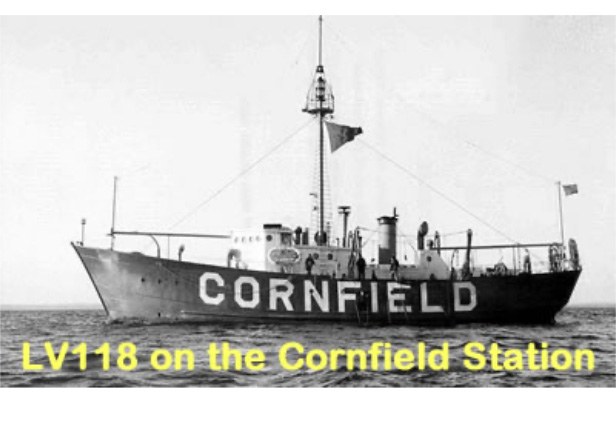Construction
The Lightship Overfalls, known to the men who served aboard as LV-118, was the last lightship built for the U.S. Lighthouse Service (USLHS). She was only one of the two lightships built in the 20th century for which the Congress made a separate appropriation for a lightship to serve on a specific station. She was built in East Boothbay, Maine in 1938 and incorporated the latest features of lightship design at the time, including steel bulkheads to compartmentalize the ship. She was the last lightship commissioned by the USLHS and the last built with a riveted construction. All subsequent lightships, and ships in general, were and are built using welded seam technology. One year after the Overfalls was commissioned, the USLHS and all of its assets (lightships, lighthouses, etc.) in 1939 were merged into the U.S. Coast Guard, so for almost all of the ship’s service life she was a Coast Guard ship with uniformed Coast Guard crews aboard.
Service History
The ship had a distinguished career serving on three significant lightship stations.
- The first from 1938 to 1957 at Cornfield Point in the east end of Long Island Sound off of Old Saybrook, Connecticut.
- In 1958, she was moved to Cross Rip near Martha’s Vineyard just south of Cape Cod.
- These stations marked the two ends of the inland passage through the treacherous shoal waters used by ships transiting from New England down to New York and points south.
- In 1962, she was reassigned to the Boston station six miles east of the lighthouse marking the entrance to Boston Harbor where she stayed until she was taken out of service in 1972.

Coming to Lewes
In 1973, the Coast Guard donated the ship to the Lewes Historical Society (LHS) to serve as a floating museum in Lewes, Delaware where she received a new name, OVERFALLS, in honor of the lightship station closest to Lewes at the mouth of Delaware Bay.
Unfortunately, critical resources were not available and preserving and maintaining the ship proved to be a challenge. By 1999, the ship’s condition had deteriorated significantly and the Lewes Historical Society tried unsuccessfully to sell it.
Fortunately, Friends of the Lightship formed as a small group within the Society and then incorporated as an independent 501(c)3 nonprofit foundation and purchased the ship for one dollar. The foundation’s initial mission was clear: save the ship, make her sustainable and put her in a proper setting.
National Historic Landmark
In 1988, the U.S. National Park Service listed the Overfalls in the National Register of Historic Places. Thanks to the thousands of hours of preservation work by countless volunteers and because of the ship’s unique characteristics (she has no sister ships which is unusual for lightships of the period which typically had one to five sister ships emanating from the same set of plans) and high degree of integrity, the National Park Service in June, 2011, designated the Overfalls a National Historic Landmark, a much more significant honor than being listed in the National Register of Historic places.
